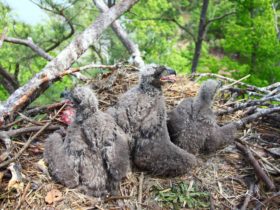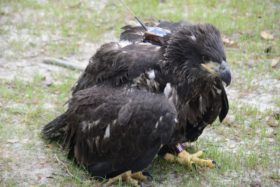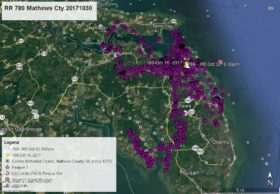Azalea has Flown 2,300 miles
Camellia Closeups June 24
June 24, 2010Camellia has Flown 54 Miles
June 29, 2010Azalea remains at the catfish ponds near Plymouth, NC as of this morning, June 26. I forgot to recognize that she had been flying since June 13, 2009. Now 1 year and two weeks. During that time, she has flown 3,781 kilometers or about 2,300 miles. She has ranged from about 125 miles north of Norfolk Botanical Garden on the shores of the Potomac River to about 100 miles south of NBG at Mattamuskeet NWR. Check out her travels at http://www.wildlifetracking.org/index.shtml?tag_id=83736




5 Comments
Thanks for the update, Reese. Interesting that she really hasn’t wandered much since finding the catfish pond – altho must be easy pickings and we know she was kind of lazy!!
A milestone- it’s been interesting! Do you have more data on Camelia? He seems to be checking out the west side of the Lynnhaven River.
see our Miss diva has been doing some traveling,but she still likes the cat-fish ? it would b so nice if her brother comes that way.thanks again to everyone that has a part with our girl and her brother.
Reese, how does Azalea’s 2300 miles compare to other eagles in their first year? Is there any norm or average for that first year? Thanks for keeping track of her.
Judy – Great question about average distance traveled in their first year of life. They range anywhere from a few hundred km to 5,000+ km. Check out our other tracking project in the Chesapeake Bay on WildlifeTracking.org. http://www.wildlifetracking.org/index.shtml?project_id=349
There’s a wide variety of dispersal distances from the natal area. The most dramatic is the eagle “Sassafras” who was banded as a nestling in 2008 in Maryland and spends her summers on the St Lawrence River in Quebec.
The eagle nestlings we study from the upper portion of the Chesapeake Bay seem to stay on the Maryland Eastern Shore or up around Conowingo Dam, MD. Azalea was raised in the southern Chesapeake Bay and has shown us important eagle areas in Virginia and (unexpectedly!) in North Carolina. These birds have very dynamic movement patterns based almost exclusively on prey availability. It seems like Azalea has found a steady food source in these commercial catfish ponds. Reese has spoken to the owners of the fish hatchery and they don’t mind the eagles being there. This is not always the case with private hatcheries so we’re thankful she’s found a safe haven.